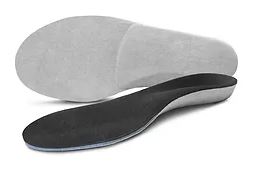It would be nice if one orthotic fit in all your shoes but in reality it cannot. It can fit in a lot of similar shoes but when we look at what makes a great orthotic we see a lot of things we do to make it that way. If we are making the orthotic for a running shoe we usually make it long to the end of the toes, we add a deep heel cup and make the orthotic a little wider (medial Shaffer) and an external heel post to get the most control we can.
If we are making it for a regular tie shoe we usually do not make it out to the toes but either to the sulcus or right behind the metatarsal heads. (See previous blog about orthotic lengths) We can still add a deep heel cup, external heel post to the rearfoot and a smaller medial Shaffer plate.
If we are making this orthotic for a dress loafer or flat which are a lot smaller we usually make the length right behind the metatarsal heads (3/4 length), no medial Shaffer and no external rearfoot post. We still can make a little deeper heel cup.
For pumps and high heels the orthotic is quite small in width to fit the shoes. Usually we make the orthotic go to the sulcus to give some padding to the forefoot. This orthotic is usually not made to control motion but to help with forefoot problems like pain and calluses. We can add pads to help control weight bearing.
So NOÖ.not every orthotic can go in every shoe, but if shoes are close in size like a sports shoe and a tie oxford we can make them fit in both. Sometimes we can make an orthotic for a menís dress and not put the forefoot extension on it and use it in a sports shoe also.




